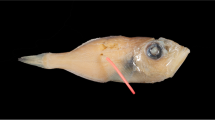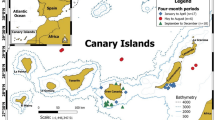Abstract
For some years investigations on the ecology of the common shore crab, Carcinus maenas, have been carried out in inshore Danish waters (the Isefjord area, Zealand) and among other things the migrations of the species were studied. In contrast to the observations from British waters of Williamson1 and others, it was observed that during the breeding season—which in the Isefjord comprises only May and June—the berried female crabs leave the littoral areas and hide in the more saline and deeper water (maximum depth 8–10 metres) until the larvæ are hatched. After this period they return to moult and copulate with the male crabs which stay all summer in shallow water (0–1.5 metres). The annual mean salinity of the Isefjord is 19.4 per mille.
This is a preview of subscription content, access via your institution
Access options
Subscribe to this journal
Receive 51 print issues and online access
$199.00 per year
only $3.90 per issue
Buy this article
- Purchase on Springer Link
- Instant access to full article PDF
Prices may be subject to local taxes which are calculated during checkout
Similar content being viewed by others
References
Williamson, H. Ch., Rep. Fish Board Scotl., 21, iii (1903).
Broekhuysen, G. J., Arch. Neerland. de Zool., 2 (1937).
Author information
Authors and Affiliations
Rights and permissions
About this article
Cite this article
RASMUSSEN, E. Behaviour of Sacculinized Shore Crabs (Carcinus maenas Pennant). Nature 183, 479–480 (1959). https://doi.org/10.1038/183479c0
Issue Date:
DOI: https://doi.org/10.1038/183479c0
This article is cited by
-
Temporal and spatial infection patterns of the rhizocephalan parasite Parasacculina leptodiae (Guérin-Ganivet, 1911) in the crab Leptodius exaratus along the shores of Kuwait
Marine Biodiversity (2021)
-
A new motile, multicellular stage involved in host invasion by parasitic barnacles (Rhizocephala)
Nature (1995)
-
Introduction, dispersal and potential impacts of the green crab Carcinus maenas in San Francisco Bay, California
Marine Biology (1995)
Comments
By submitting a comment you agree to abide by our Terms and Community Guidelines. If you find something abusive or that does not comply with our terms or guidelines please flag it as inappropriate.



